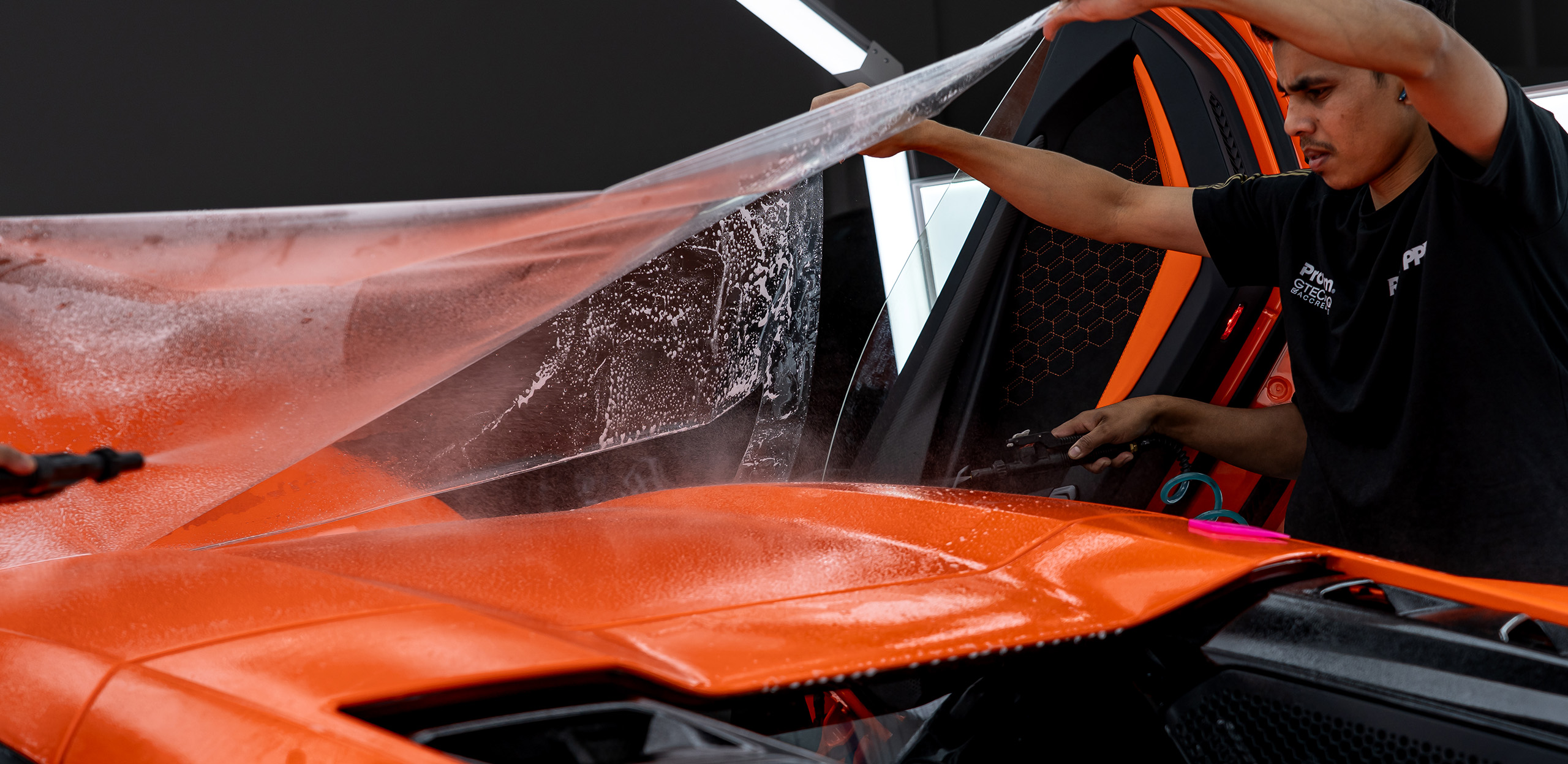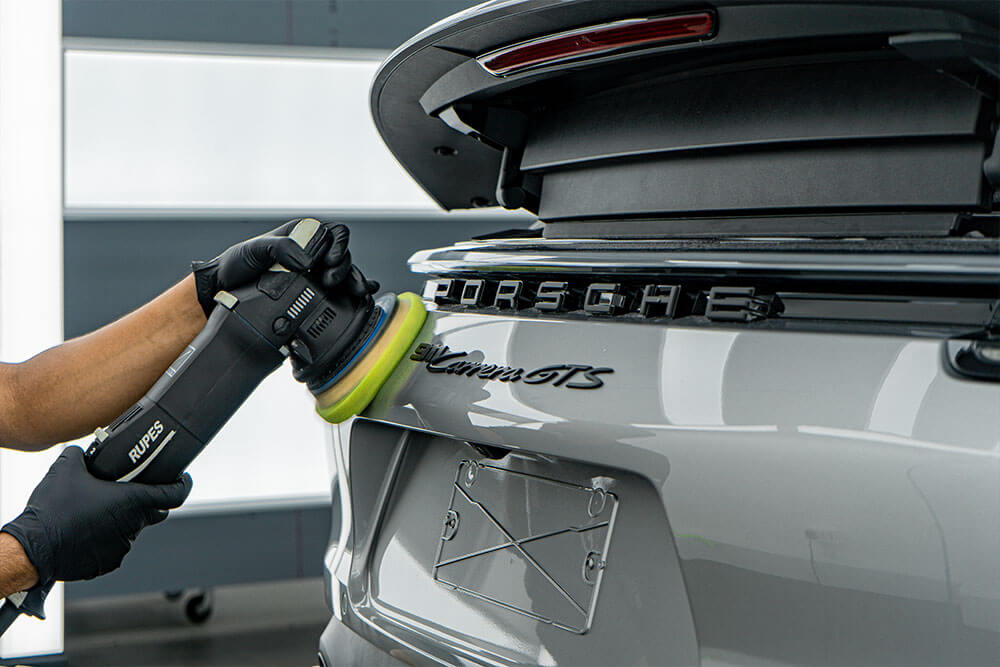
You know that truly satisfying moment in car detailing? It’s not just the final gleaming shine; it’s when you see the undeniable, chemical proof that your car is actually deeply clean. When you spray on an iron remover and your paint starts to “bleed” purple, you’re witnessing it dissolving those invisible, embedded iron particles from brake dust – the stuff no amount of regular washing can ever touch. For years, the only real weapon against this nasty stuff was the traditional clay bar. But let’s be honest, that was a high-risk game: one accidental drop on the garage floor, and your twenty-dollar tool instantly transforms into a tiny puck of sandpaper, ready to inflict deep, painful scratches into your clear coat. Ugh.
Fast forward to 2025, and thankfully, that high-risk, all-or-nothing approach is pretty much a thing of the past. Today’s modern decontamination strategy is a much smarter, two-pronged attack. We’re now cleverly using advanced chemical decontaminants to tackle those embedded particles, and then following up with safer, reusable mechanical tools like clay mitts for the surface-level grime. This isn’t just some passing trend; it’s a fundamental shift towards methods that are simply safer, way more effective, and deliver professional-level results without all those nerve-wracking risks of the old days.
It’s time to really break down this new way of doing things. Let’s dive into the science behind each tool and lay out the definitive, expert-recommended process for getting that perfectly smooth surface – the ideal foundation for any wax, sealant, or serious car paint protection you want to apply.
The “Why”: What Are You Really Trying to Get Off Your Car?
Before we even talk about how to decontaminate, it’s super important to understand the two distinct types of crud you’re battling at this stage of car detailing. A simple car wash is great for loose dirt, but it’s completely powerless against those bonded contaminants that make your paint feel rough and gritty. These nasties generally fall into two main categories:
- Above-Surface Contaminants: These are the obvious offenders, the ones you can often feel and sometimes even see. They just sit right on top of your car’s clear coat and include stubborn stuff like road tar, sticky tree sap, and even paint overspray from that annoying construction next door. While they haven’t actually dug into the paint, they’re bonded on there tight and won’t budge with just soap and water.
- Below-Surface Contaminants: Now, these are the more sneaky and frankly, more damaging types. We’re talking about microscopic iron particles that come from your car’s own brake dust, plus industrial fallout from railway lines and construction sites. These hot, tiny, sharp particles literally embed themselves into your clear coat. If you leave them there, they can start to oxidize and cause those tiny, permanent rust spots within your paint, totally compromising the integrity of your car paint protection. And here’s the kicker: you can’t get these out with just washing or even traditional claying alone.
The Old Guard: The Traditional Clay Bar
For decades, the classic clay bar was pretty much the only game in town for serious car detailing enthusiasts who truly wanted that “glass-smooth” surface. And the process itself is a classic for a reason: after lubricating a panel, you gently glide a piece of detailing clay across the surface. The clay’s tacky nature physically grabs and pulls those bonded, above-surface contaminants right out of the paint, leaving it feeling incredibly slick.
For a long, long time, it really was the most effective method available.
However, in 2025, its downsides have become just too glaring to ignore. First off, it’s slow and pretty tedious, requiring you to constantly knead the clay to expose a fresh, clean surface. But its single most critical flaw is its catastrophic “oops” moment: if you drop a piece of clay on the ground, even for a second, it’s instantly and permanently contaminated with abrasive grit. You can’t wash it clean. You have to throw it away immediately. Continuing to use it would literally be like rubbing sandpaper all over your car’s paint. That makes it an unacceptably high-risk tool in today’s smart car detailing arsenal. No thanks!
The Modern Evolution: Clay Mitts & Towels – Smarter, Safer!
All those inherent risks and the frankly tedious nature of the traditional clay bar really paved the way for its modern, much smarter evolution: the clay mitt and the clay towel. This upgrade is a huge leap forward in both the safety and efficiency of mechanical decontamination, a crucial step in truly professional car detailing.
These awesome tools feature a specialized, high-tech polymer rubber layer bonded to one side of a standard microfiber mitt or towel. They operate on the same basic principle as a clay bar – gliding over a lubricated surface to physically shear off and pick up those bonded, above-surface contaminants.
But they offer two game-changing advantages that you need to know about:
- Speed and Efficiency: A clay mitt or towel has a much, much larger surface area than a tiny piece of clay. This means you can decontaminate entire panels in a fraction of the time, dramatically speeding up your car detailing process. More done, less time!
- Reusable and Dramatically Safer: This is the biggest improvement, in my opinion. If you accidentally drop a clay mitt on the ground, you don’t have to just toss it out! Unlike a traditional clay bar, which is instantly ruined, you can simply rinse the polymer surface thoroughly in your wash bucket to remove any grit, and then safely continue working. This one feature virtually eliminates the risk of that catastrophic scratching that made the old clay bar such a high-stakes tool. What a relief!
The Chemical Revolution: Iron & Tar Removers – It’s Like Magic!
The most significant leap forward in modern car detailing is absolutely the shift from relying solely on mechanical decontamination to a much safer, more effective chemical-first approach. This revolution is powered by two specialized heroes: iron removers and tar removers.
The science here is what makes this method so brilliant. Iron removers are pH-neutral sprays containing a special chemical that literally sniffs out and reacts specifically with those ferrous (iron) particles embedded in your paint from brake dust and industrial fallout. When you spray the product on, it starts to dissolve these iron particles, causing them to turn a deep purple color and famously “bleed” down the panel. This amazing bleeding effect is your visual proof that the chemical is doing its job, breaking down those most harmful contaminants into a water-soluble solution that you can then just safely rinse away. Tar removers work similarly, using specialized solvents to break down and dissolve sticky, petroleum-based contaminants like road tar and leftover adhesive gunk.
The single greatest benefit of this method? It’s a completely touchless form of decontamination for the really nasty stuff. You’re removing the most deeply embedded and damaging particles from your car’s paint protection surface without any physical scrubbing, rubbing, or abrasion. You literally just spray, wait for the magic chemical reaction, and then rinse. This is the absolute pinnacle of safe car detailing, as it totally eliminates the risk of scratching while specifically targeting the contaminants that mechanical methods simply can’t safely reach or remove. It’s genius.
The Verdict: Building Your 2025 Decontamination Strategy – Be Smart!
So, the debate in modern car detailing isn’t really about which single decontamination method is the best anymore. Relying on just one tool is honestly an outdated approach. A clay mitt can’t safely remove those sharp, embedded iron particles that a chemical remover can, and an iron remover isn’t going to lift stubborn, above-surface tree sap that a clay mitt will. The true, professional-grade strategy for 2025 is a multi-step process that intelligently uses the strengths of each technology, in the correct order, for maximum safety and effectiveness.
Here is the definitive, expert-recommended process for achieving a flawless, scratch-free decontamination:
Step 1 (Chemical First): Always, always start with a chemical decontamination. After you’ve given your car a good wash and rinse, hit it with a high-quality iron remover and, if you see any, a tar remover. This “touchless” first step safely dissolves and removes the most harmful, embedded contaminants without you ever having to physically scrub the paint. This is, hands down, the safest way to detail your car.
Step 2 (Modern Mechanical Second): After you’ve thoroughly rinsed away all those chemical cleaners, then you can move on to a mechanical decontamination. Using a modern clay mitt or towel (and, seriously, never a traditional bar) with plenty of lubrication, gently glide it over the paint to shear off any remaining, less-harmful above-surface contaminants like sap or paint overspray.
This specific order is absolutely crucial. By chemically removing those sharp, embedded iron particles first, you make that subsequent mechanical step infinitely safer, because you’re no longer dragging microscopic metal shards across your beautiful paint. This combined approach ensures you remove 100% of bonded contaminants with the absolute minimum risk of inflicting scratches, creating that perfect foundation for any car paint protection you’re planning.
Detail Smarter, Not Harder!
The modern philosophy of car detailing is super clear: that two-pronged attack of chemical and modern mechanical decontamination is the definitive, expert-recommended method for 2025. It’s a smarter, safer, and just plain more effective approach that lets advanced chemistry do the heavy lifting, seriously minimizing the risk of physical abrasion to your paint.
It’s truly time to upgrade your car detailing toolkit and, more importantly, your technique. Ditch that risky, old-school clay bar and wholeheartedly embrace a multi-step process that kicks off with a chemical deep clean before moving on to a safer mechanical polish. This is the absolute key to achieving that truly flawless, glass-smooth finish that serves as the essential foundation for any long-lasting wax, sealant, or car paint protection. Your car (and its paint) will thank you!


